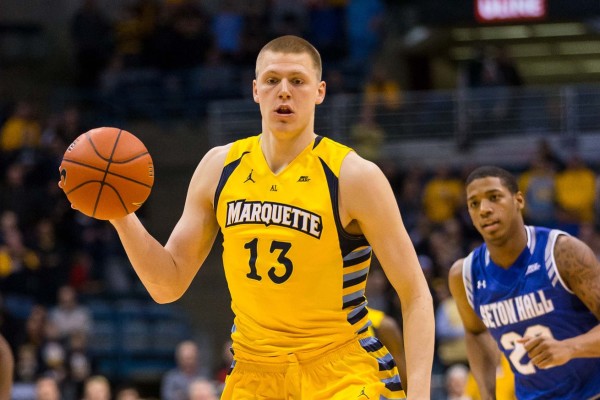Marquette’s Troubles Begin With Its Pace
Posted by Justin Kundrat on January 29th, 2016Marquette may have already matched last season’s win total, but conference success has been hard to come by. A once-dominant, perennial contender in the Big East has fallen by the wayside following the departure of Buzz Williams. And while expectations have been tempered for first-time head coach Steve Wojciechowski, the frustration is already evident. On its face, the Golden Eagles’ frontcourt pairing of Indiana transfer Luke Fischer – an experienced junior with a plethora of post moves – and highly touted freshman Henry Ellenson forms the core of the best offensive frontcourt in the conference. Unsurprisingly, the team is sporting both its best two-point field goal percentage offense and defense of the last 15 years. Marquette has thrived when working through the post, a reality made even more evident when the Golden Eagles shot 54.8 percent inside the arc against Villanova, a team that usually holds opponents to 41.9 percent two-point shooting (16th nationally).
Yet for a team that plays so well in the paint (Fischer and Ellenson shoot a combined 70% at the rim), the team’s offense has been undermined by an odd plan of attack. Entry passes or pick-and-roll plays that have commonly resulted in easy Golden Eagles points are scarcely used; instead, Wojciechowski’s team is playing at an unsustainably quick pace, averaging just 15.7 seconds per possession on offense. The team’s average offensive possession length has decreased from 18.6 seconds (198th nationally) to 15.7 (34th nationally) over the course of one season. This figure is undoubtedly distorted by a high turnover rate and low rebounding rate, but those two issues also plagued last year’s team, and to a similar extent. Perhaps as a result of the relative inexperience of its backcourt players, the quickened pace has Marquette turning the ball over on 20.5 percent of all its possessions, which puts them 296th nationally in the category.
Tempo semantics aside, perhaps the most perplexing part about this team is its inability to rebound. With two 6’11” players in its frontcourt and no shortage of athletic guards, a team whose effective height is 28th nationally somehow ranks 201st in offensive rebounding and 225th in defensive rebounding. On its face, this problem just does not make sense. Dive deeper, though, and it appears the root of the issue lies both in team tendencies and the weak interior rebounding of Fischer. Ellenson has put together impressive rebounding metrics (74th nationally in DR%), but with minimal interior depth behind the starters, Marquette has struggled in situations when either Fischer or Ellenson is off the floor. This problem is further amplified by that quick pace: Marquette likes to get up and down the floor so fast that guards are often unable to crash the boards to help. As such, second chance opportunities are surrendered at the expense of trying to find transition points. Moreover, the 6’11” Ellenson’s tendency is to play a perimeter-oriented game; just 25 percent of his shots come at the rim, which is second lowest on the team behind only 6’2″ guard Duane Wilson. Naturally, as Ellenson floats the perimeter, his own offensive rebounding opportunities are bound to be limited. On Wednesday night, the Golden Eagles allowed a Stetson team with one of the smallest lineups in the country to corral 36.6 percent of its offensive rebounding opportunities, its highest of any game this season. Oh, and the Hatters have played four Division II or NAIA opponents this season.
Needless to say, Marquette simply isn’t playing at a pace that is conducive to its strengths. It’s high time that Wojciechowski re-engineers the offense to build an attack predicated on entry passes and post offense. The burden of initiating offense should no longer belong strictly to guards who have cost the Golden Eagles too many possessions. The Marquette strength lies inside with Ellenson and Fischer, and the offensive game-plan needs to begin reflecting that.











































